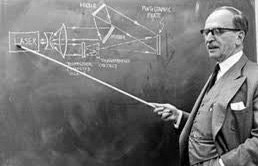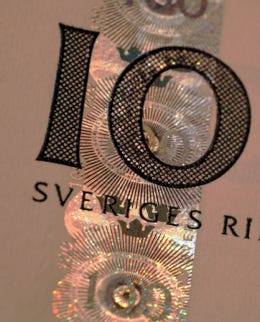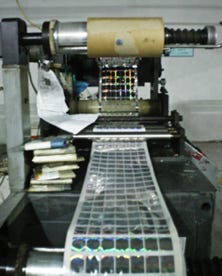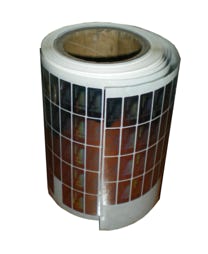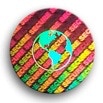Holographic and Anti-Counterfeit Labels: The Solution for Product Security
In today's market, counterfeiting is a growing problem that causes losses of millions of euros every year for official manufacturers. Consumers are increasingly careful to verify that the products they purchase are original and genuine, choosing items with anti-counterfeit labels, such as holograms. Thanks to laser technology, anti-counterfeit adhesive holograms have become the most effective method to protect products against counterfeiting.
Renowned companies such as Sony, Canon, Microsoft, Motorola, Adidas, Dolce & Gabbana and many others, use custom holographic emblems to protect their reputation and prevent counterfeiting.
Our Holograms: Security and Commercial Image
Our anti-counterfeit holograms are made with modern laser technologies, offering not only a high level of protection, but also a visual impact that strengthens the image of the brand. Thanks to the efficiency of our production, we can offer very competitive costs, making our holograms accessible even to small and medium-sized companies.
Historical Notes on Holography
Holography was discovered in 1948 by physicist Dennis Gabor, who received the Nobel Prize in 1971. The first white light hologram was created by Denysiuk in the USSR. Even today, holography offers the most accurate three-dimensional representation of an object, making this technology the benchmark for anti-counterfeiting protection.
Holography as an Anti-Counterfeiting Method
The concept of commercial holography was born from the need to create an identification method that was easily recognizable even by non-experts, but at the same time complex and sophisticated, making duplication by photocopying, scanning or printing impossible. Thanks to recent technological developments, the production of holograms has increased 5 times compared to the 1990s, favoring the growth of the holography market for anti-counterfeiting.
The Technology Behind Holograms
A hologram or DOVID (Variable Optical Identification Device) is a three-dimensional element that varies the image depending on the angle of light, impossible to reproduce with scanners or photocopiers. The hologram can be used on security papers, as a transparent or metallized laminate, to protect identity documents, passports and identification cards.
3D Holograms and Technological Applications
3D holograms encode the three-dimensional information of an object during the recording phase and, when correctly illuminated, reproduce the image for the observer. Unlike other 3D images, the hologram has parallax, allowing the subject to be observed from different points of view. This technology is also used in the aeronautical and automotive fields (as in the heads-up display system), as well as for very high density data recording, with future applications in the IT field.
Quality and Advanced Technology in Holographic Processors
Since 1992, our company has been offering a complete range of cutting-edge holographic processors. Our laboratories are equipped with two dot-matrix printing sets and three 2D/3D hologram printing sets, which, combined with our many years of experience in the sector, guarantee high quality products and efficient customer service.
In addition, we have laser numerical printers, ideal for creating progressively numbered alphanumeric serial numbers, a particularly useful feature for product traceability and safety needs.
DOT-MATRIX Technology: Innovation in Anti-Counterfeiting Holography
The DOT-MATRIX system uses advanced optoelectronic equipment with Helium-Cadmium Laser to create high-precision holographic images. Connected to a PC, this system traces a Computer Graphics image point by point directly onto a Photoresist plate. After development and galvanic growth with nickel, the resulting matrix is used for the embossing process (hot embossing) of the holograms.
This technique allows the creation of a matrix of diffractive gratings of a few microns in size, recorded in succession by laser beams. Thanks to automated control, kinetic effects such as expansions, contractions, rotations and shades can be obtained. Resolution can reach up to 2400 dpi, ensuring extremely high image quality.
2D and 3D Holograms: Depth and Multichannel
2D-3D holograms offer a true three-dimensional effect, not only as an optical illusion, but as a storage of depth information. Two-dimensional objects are arranged at different depths to create a unique visual experience. In addition, 2D-3D technology allows the creation of multi-channel effects and cinematisms, offering the possibility of reproducing a sequence of images while rotating the hologram along the vertical axis.
3D holograms, on the other hand, include a three-dimensional physical model that comes out of the holographic plane. The holographic image is a complete representation of the wavefront emitted by an illuminated object, allowing the visual perception of the object as if it were observed in reality. Reproducing a 3D hologram requires the creation of a model identical to the original, with the same lighting and color combination.
Hologram Security Anti-counterfeiting
Each holographic label represents a unique security element. Without the original holographic printing matrix, it is practically impossible to reproduce an identical hologram, unless you face very high costs. For the most sophisticated needs, we offer high-security holographic labels, including encrypted and secret code holograms, which contain hidden information visible only with special tools.
Labels can also be made with anti-infringement materials or with "Wipe Out" technology, which destroys the label in case of removal attempts. In addition, it is possible to add micro-text and secret codes, visible only with specific equipment. The use of fluorine elements invisible to the naked eye but visible under UV light, is an innovative technique widely used, for example, for the detection of banknotes.
Counterfeiting: Definition and Regulation
Counterfeit goods, as defined by Art. 2 sub 1 letter a) of Reg. n.1383/2003, include all those products that bear unauthorized trademarks or trade marks and that infringe the rights of the owners of registered trademarks. These products infringe Community regulations on the Community trademark and the legislation of the Member States.
Pirated goods, as defined by Art. 2 sub 1 letter b) of Reg. n.1383/2003, include copies made without the consent of the owner of the copyright or design, whether registered or unregistered, thus violating Regulation (EC) n.6/2002. For further information on the regulation and protection of intellectual property rights, we invite you to visit the European Community website.

